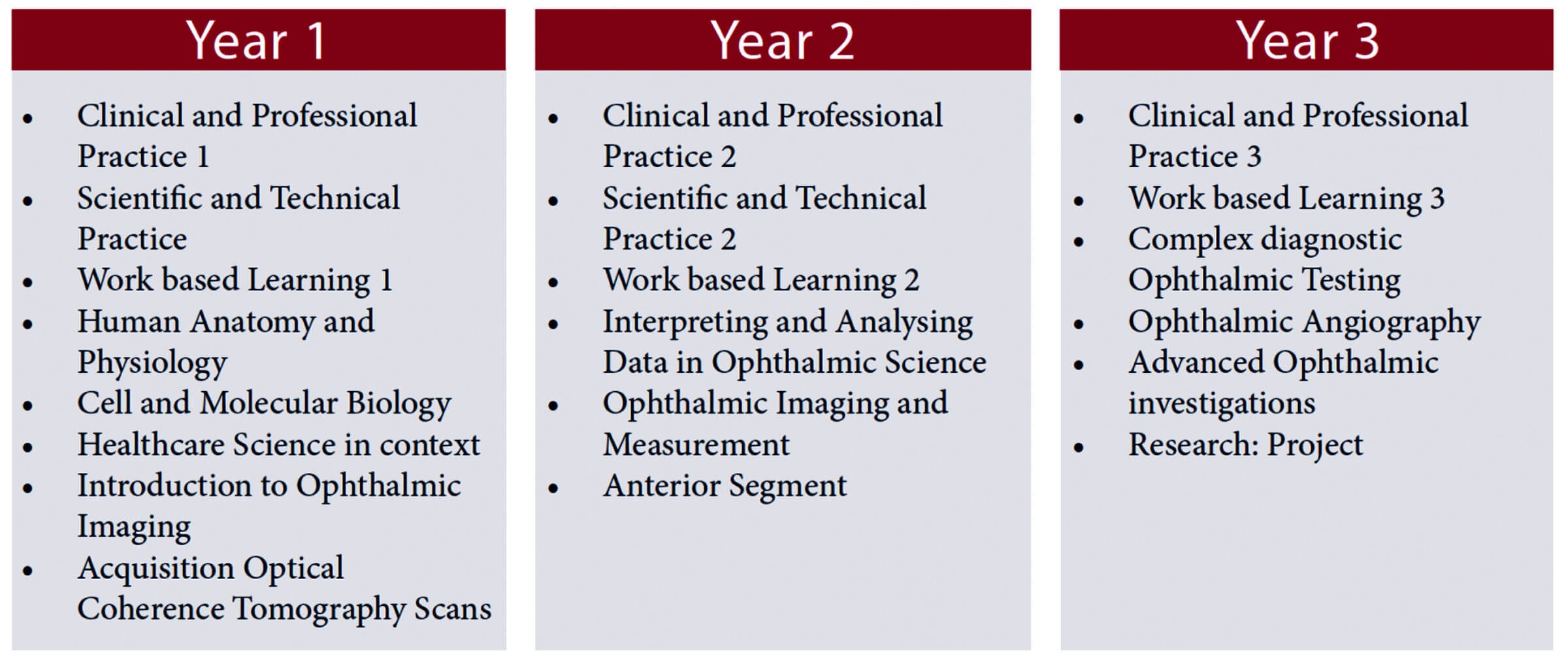Ophthalmic science is a dynamic and constantly evolving profession, with ophthalmic imagers / technicians fundamental to the smooth and efficient running of ophthalmology departments. Traditionally, as the role has developed, ophthalmic imagers have come from a variety of backgrounds, finding their way into ophthalmic imaging from areas such as photography, nursing, eye screening and optometry or the sciences. Knowledge and skills have been learnt on the job and through experience, as opportunities for formal specific training have not been available.
The Gloucestershire Retinal Education Group (GREG) led by Professor Peter Scanlon, based at Gloucestershire Royal Hospital has been running educational courses (including a degree in optical coherence tomography) for over 10 years. However, they have been keen to provide an opportunity for the skills and experience of ophthalmic imagers to be formally recognised and to provide a recognised qualification within this field. In 2020, Prof Scanlon approached the National School of Healthcare Science and reached an agreement with them to develop an additional pathway to the healthcare science degree with the focus on ophthalmic imaging.


Since then, GREG have been working with the University of Gloucestershire and other professionals in the field. There is widespread recognition that ophthalmic imaging as a growing area is becoming more and more technical and therefore requires degree-level learning. The BSc (Hons) in Healthcare Science (Ophthalmic Imaging) will provide much needed opportunities for this section of the workforce.
Prof Peter Scanlon said: “I have for many years felt that there should be a recognised qualification in ophthalmic imaging but the original structure that had been set up for healthcare science qualifications involved working in a number of other departments which always seemed impractical. With the current more flexible approach by the National School, this degree can focus on ophthalmic imaging and it is possible to attract apprenticeship levy funding for some students. I hope this will be an attractive prospect for those who wish to undertake a degree ‘on the job’.”
A first of its kind qualification
Launching in September 2022, the degree has been specifically developed to support the growing need for qualified technically skilled ophthalmic imaging practitioners. Teaching will be delivered over three years, with learners achieving a BSc (Hons) in Healthcare Science (Ophthalmic Imaging) upon completion. This enables the learners to apply for professional registration with the Academy of Healthcare Science.
The degree will give all current and new ophthalmic imagers and aspiring ophthalmic technicians the opportunity to gain a recognised qualification in their chosen career pathway for the first time, where no other degree of its kind exists.


This degree will be delivered by the University of Gloucestershire with the Ophthalmic Imaging specialist modules provided by the GREG. Course Lead in Healthcare Science at the University of Gloucestershire is Tracy Longden Thurgood. She said: “As a qualified healthcare science professional, with a passion for education and training, it is fantastic to have co-developed a degree course that will finally recognise the professional role of an ophthalmic imager. Completing the degree will ultimately provide graduates with the knowledge, skills and clinical behaviours needed to enable this specialist workforce to deliver high quality patient care for years to come.”
The programme is delivered via a blended-learning approach, which combines distanced learning with the development of clinical skills in practice. Students will spend some study time at the University and return to their place of work to continue application in practice, with support provided via online learning platforms. The programme is ideal for employers who are looking to develop their own staff, as well as those looking to train new entrants to the profession.
“This exciting new course will cover all aspects of an ophthalmic photographer’s training. With increasing clinical demand, it will take some of the pressure off departments and ensure a high standard of practice / imaging. With so many different ophthalmic techniques being covered, students will have a very broad knowledge and skill set, allowing the possibility for extended roles, community clinics and increased virtual activity” Emily Hogan
– OIA Chair Elect
Modules are delivered through a combination of online lectures, action learning sets, clinical skills sessions, seminars and class-based discussions. Clinical skills blocks will be scheduled in advance and avoid peak clinical periods to help with planning around work and personal commitments. Learners will attend approximately five study blocks in year one, and four blocks in years two and three.
The programme of study
In the first year the course provides a basic grounding in aspects of healthcare science but with attention to how these relate to the eye and ophthalmic imaging. Specific ophthalmic imaging modules in year one focus on routine tests used in ophthalmology, e.g. fundus imaging, visual acuity, visual fields, topography, keratometry and acquisition of OCT scans.
In year two the emphasis is on specific skills in ophthalmic imaging, e.g. advanced confocal scanning ophthalmoscopes, fundus autofluorescence, interpretation of OCT scans and anterior segment imaging, while still retaining the overall requirements of healthcare science.
In year three, while developing the independent practitioner, the clinical learning includes, for example, more complex diagnostic testing, such as ocular ultrasound techniques, perimetry, advanced OCT and practical application of angiography (see below).

How to apply
Applications are open now. The qualification is available from September 2022 and application is available via two routes:
- Apprenticeship route – based in the workplace with access to apprenticeship funding
- Direct entry – full-time university course with work-based placements.
For employers and current employees, the route of choice is via the apprenticeship, this route is fully funded and available to new and existing employees.
Apprentices should be in full-time employment (e.g. employed for at least 30 hours per week) throughout the duration of the apprenticeship. Exact entry requirements are set by the employer, but typically include GCSE grade C/ 4 or above in maths and English language.
Further information is available at www.gregcourses.com or https://www.glos.ac.uk/courses/course/dahso-da-healthcare-science-practitioner-l6/
A Bsc (Hons) in Healthcare Science (Ophthalmic Imaging) provides an existing workforce the opportunity to receive academic recognition for their knowledge and skills in this speciality.
It considers the apprenticeship route as a valid, achievable training route for new staff and is a unique opportunity which is not available anywhere else at the present time.
It is the first step towards a clear career pathway for those working in ophthalmic science and brings this group of workers clearly under the healthcare science umbrella, with the opportunity to register with the Academy of Healthcare Science.
Declaration of competing interests: None declared.
COMMENTS ARE WELCOME






